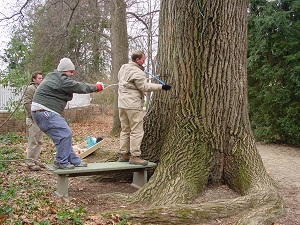Oxford Tree-Ring Laboratory - Virginia
Virginia

Trees from the estate, Mount Vernon, Fairfax, VA (38.708512, -77.087771)
Summary: During 2004 and 2005 some 40 trees were sampled in the gardens and surrounding Estate at Mount Vernon, of which 38 produced usable core samples. Of these, 11 were from on or around the Bowling Green, 3 from the area in front of the Mansion on the top of the escarpment overlooking the Potomac, with 5 more on or below the escarpment itself. A further 7 trees were sampled in the woodland to the east of the Mansion, 3 to the north, and 9 to the west at the top of the steep escarpment. Of the trees sampled, 16 were oaks, predominantly White oaks (Quercus alba), with a few other varieties including the Swamp chestnut oak (Q. michauxii Nutt), Red oak (Quercus rubra ), and Chestnut oak (Quercus prinus). Two White ash (Fraxinus americana) were sampled, as well as 5 Yellow-poplar (Liriodendron tulipifera), 4 Pitch pine (Pinus rigida Mill.), 4 American holly (Ilex opaca), and one each of Baldcypress (Taxodium distichum), Kentucky coffeetree (Gymnocladus dioicus), Mockernut hickory (Carya tomentosa), White mulberry (Morus alba), Eastern hemlock (Tsuga canadensis), American Beech (Fagus grandifolia Ehrh.), and American elm (Ulmus minor Mill). The oak trees were cross-matched and 15 were found to match each other, producing a 220-year chronology extending back to 1786 and providing a replicated, independently-dated reference chronology to cross-check some of the other species as well as provide a chronology to date later oak structures within the immediate vicinity of Fairfax County. Of particular interest were to try and determine which trees were possibly propagated by George Washington during his improvements to the gardens and Estate at Mount Vernon. A total of 10 were determined to be old enough to date from this period of pre-1799, one from the western escarpment might even pre-date the tenure of George Washington. On the Bowling Green, two trees were determined to have been planted during the George Washington era: an Eastern hemlock and a Yellow-poplar, both located on the eastern side of the green. A second Yellow-poplar on the western side of the green is of equal size and although not sampled, it is almost inconceivable to imagine it not being coeval as the one sampled. Although it was not possible to prove it through the dendrochronology due to an area of decay within the tree, a White mulberry is most likely to predate 1800. On the eastern side of the Mansion, two of the oak trees sampled were also determined to have been planted during this period, if not earlier. Outside the historic core surrounding the Mansion, a number of oaks and pines, mainly to the west along the steep escarpment were found to have a number of trees dating to the period of GW. This is of interest, as it might relate to a scheme of planting that has survived to this day. One of these, a Pitch pine, extended back about 300 years, predating any planting by GW. Although the core extracted during 2004 did not have more than 125 rings until a rot pocket was encountered, one taken some years ago by Dean Norton had about 300 growth rings.
Miles, D H, and Worthington, M J, 2006 “ The Tree-Ring Dating of Trees from the Mount Vernon Estate and Gardens, Fairfax County, Virginia ”, ODL unpubl rep 2006/34
Link to the Mount Vernon's wedpage here
Oxford
Tree-Ring
Laboratory
The Oxford Tree-Ring Laboratory provides cutting-edge commercial dendrochronological services to homeowners, architectural historians, and cultural resource managers. READ MORE
Contact Information
Oxford Tree-Ring Laboratory
ProprietorsMichael Worthington
Jane Seiter, Ph.D
25 E. Montgomery St.
Baltimore, MD 21230
410-929-1520